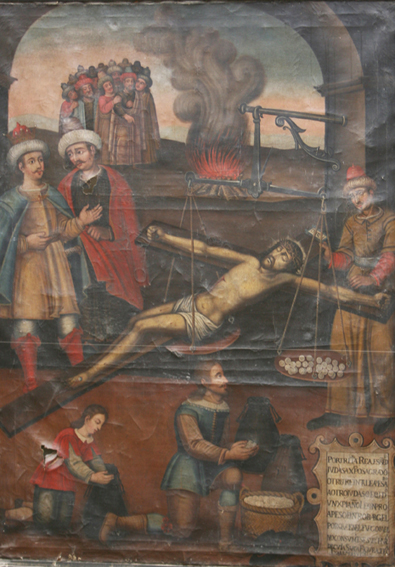The piece of the month of March 2009
A CANVAS OF THE CHRIST OF THE RESCUE OF VALENCIA IN TUDELA
Ricardo Fernández Gracia
Chair of Navarrese Heritage and Art
In the staircase of the palace of the marquises of Huarte de Tudela -nowadays library and municipal file of the city-, hangs, together with other canvases coming from parishes and convents of the capital of the Ribera, a curious painting that narrates the particular history of a venerated image of the Spanish east.
According to inventories conserved in the file of the Town Hall of Tudela, it comes from the disappeared convent of San Antón of the same city, according to a list of goods of that institution dated in 1791.
It is the story of the Christ of the Rescue that received secular worship since 1539 in the disappeared convent of Augustinian nuns of San José and Santa Tecla and is currently in the parish of San Esteban de Valencia.
The painting (232 x cms.), with evident connotations of description and narrativism, belongs to the central decades of the 17th century. It narrates the acquisition of a sculpture in Muslim lands in North Africa by a Christian in successive parts throughout the composition. In the background appears a bonfire in which the sculpture was going to be destroyed and burned, in the center the weight and the sale of the sculpture and in the lower part the Christian knights Pedro and Andrés de Medina who observe the miracle of the balance that does not admit "neither more nor less" than the thirty silver coins, since it had been agreed that the Crucified would be given to the Medina brothers for its weight in silver coins.

"Canvas of the Christ of the Rescue of Valencia". XVII Century
Palace of the Marquises of Huarte. Tudela
A registration in the lower right part financial aid to identify the topic and the narrated story : "FOR THIRTY REALS JUDAS BLESSED / JUDAS TO SACRED CHRIST / ANOTHER THIRTY REALS TO HEAVY / TO ANOTHER JUDAS. THAT REMAINED / A CHRISTIAN BOUGHT HIM / BY WEIGHT IN ALGIERS / SO THAT IN THE CRUEL FIRE / HE WOULD NOT BE CONSUMED IN THE CRUEL FIRE / OF WHOSE HOLY FIGURE (....) / IN VALENCIA IS HIS FAITHFUL".
It is a very interesting painting from the anthropological point of view, exponent of a culture with an exalted religiosity, in which the prodigious and the marvelous were united with the ecclesiastical and civil powers to maintain the principle of religious unity around Catholicism. In this regard, and although in relation to the Jews, we must mention another curious story, that of the Christ of Patience of the Capuchins of Madrid, so popular in writings and prints in the sixteenth century.
The poor artistic quality of the canvas is compensated by the details of all subject that can be seen in the painting: costumes, attitudes, faces, weight, headdresses and especially in the hats typical of the figure of the "bad guy" in the executioners of martyrdom and in the soldiers of Herod in the Nativity scenes. The parallels between the biblical Judas and the "New Judas" are evident in the registration that attests and attests to the indoctrinating intentions of the painting.
The Christ was known in Valencia as the Christ of the Rescue and received worship in the disappeared convent of Augustinian nuns of San José and Santa Tecla (today in Picasent), until it was transferred to the parish of San Esteban.
The history of the image of the Cristo del Rescate was well known in its time. According to the oral and written account collected in the tradition, at the beginning of the 16th century, the pirates of Algiers boarded a ship in the Mediterranean that was heading to Barcelona, seizing the cargo and the crew. The crew members were sold as slaves in the Algiers market and among the seized cargo was the carved wooden image of a Crucified Christ. The pirates threw the carving of Christ into the fire and were surprised to see how the fire did not consume the wood.
In Algiers were, at that time, the brothers Pedro and Andrés de Medina negotiating the liberation of a sister of theirs who years before had been kidnapped in an attack of pirates in the Valencian coast. When the brothers learned of the miracle that had occurred with the Christ, they appeared before the pirate chief with the intention of paying a ransom for the image. They agreed that the price of the ransom would be the weight of the carving in silver coins. Placed the Crucifix on a scale, again a miracle was worked, because the weight plate only admitted thirty silver coins, not one more, so the pirate, much to his regret, had to submit the image to the Medina brothers who embarked to Valencia. Even before leaving those lands another miracle took place and it is that the ship that had to take them back did not advance, and it is that the figure of Christ was missing a finger and only when they recovered the finger and placed it to the image, the ship could set sail. The Medina's sister was never heard from again, as they were unable to free her. The image arrived in Valencia in 1539.
Unfortunately, numerous pieces of this subject, either of miraculous stories, votive offerings or trompe l'oeil to the divine have been lost or destroyed, depriving us of elements not inconsiderable to understand the past. Once the content of the painting has been identified, we still need to know how it arrived in Tudela and others data such as the hypothetical cult it may have received in the city and the exact location it had in the convent of the Antonianos.
